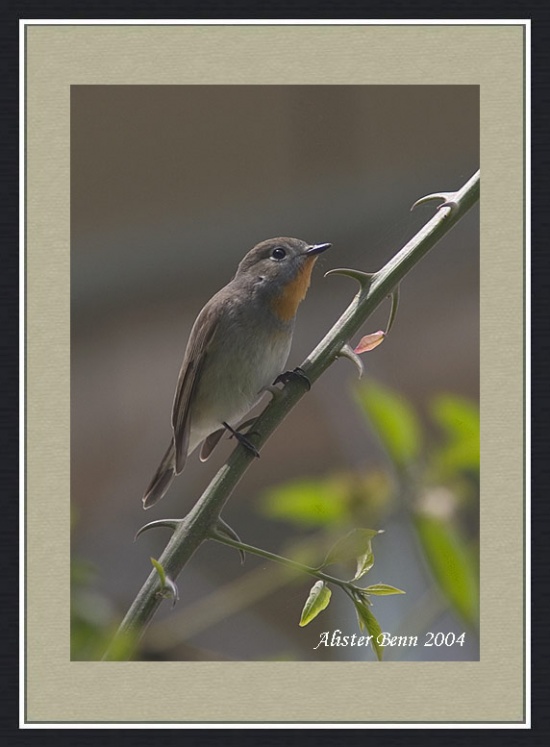m |
(User template. ID re-written as virtual C&P. Bird Song category) |
||
| Line 1: | Line 1: | ||
| − | [[Image:Red-breasted_Flycatcher.jpg|thumb|550px|right|Photo by Alister Benn]] | + | [[Image:Red-breasted_Flycatcher.jpg|thumb|550px|right|Photo by {{user|alibenn|Alister Benn}}]] |
;[[:Category:Ficedula|Ficedula]] parva | ;[[:Category:Ficedula|Ficedula]] parva | ||
'''Includes: Taiga Flycatcher''' | '''Includes: Taiga Flycatcher''' | ||
==Identification== | ==Identification== | ||
| − | 11-12 cm | + | 11-12 cm |
| + | *Ashy-brown upperparts, paler beneath<br /> | ||
| + | *Brown bill <br /> | ||
| + | *Dark brown legs<br /> | ||
| + | *Noticeable white patches at base of tail<br /> | ||
| + | '''Male'''<br /> | ||
| + | Bright reddish-orange throat and upper breast<br /> | ||
| + | '''Female and Juvenile''' duller brown above and whitish below<br /> | ||
| + | |||
| + | Often flicking and cocking tail and sits with 'drooping wings' | ||
==Distribution== | ==Distribution== | ||
[[Europe]], central [[Asia]]; migratory, wintering in south [[Asia]]. | [[Europe]], central [[Asia]]; migratory, wintering in south [[Asia]]. | ||
| Line 11: | Line 20: | ||
Deciduous woodland near water. | Deciduous woodland near water. | ||
==Behaviour== | ==Behaviour== | ||
| − | An open nest in a tree hole is built and 4-7 eggs are laid. | + | ====Breeding==== |
| − | == | + | An open nest in a tree hole is built and 4-7 eggs are laid. |
| + | ====Diet==== | ||
| + | It feeds by taking insects in flight and caterpillars from among oak leaves. It also eats berries. | ||
| + | ====Flight==== | ||
| + | Flycatches from perch, and will also 'glean' warbler-like amongst leaves. | ||
| + | ====Vocalisation==== | ||
<flashmp3>Ficedula parva (song).mp3</flashmp3><br /> | <flashmp3>Ficedula parva (song).mp3</flashmp3><br /> | ||
''[[Media:Ficedula parva (song).mp3|Listen in an external program]]'' | ''[[Media:Ficedula parva (song).mp3|Listen in an external program]]'' | ||
| + | ==References== | ||
| + | #Wikipedia | ||
| + | #Birdwatchers Pocket Guide ISBN 1-85732-804-3 | ||
| + | #Collins Pocket Guide to British Birds 1966 | ||
| + | #Collins Field Guide 5th Edition | ||
==External Links== | ==External Links== | ||
{{GSearch|Ficedula+parva}} | {{GSearch|Ficedula+parva}} | ||
| − | [[Category:Birds]] [[Category:Ficedula]] | + | [[Category:Birds]] [[Category:Ficedula]][[Category:Bird Songs]] |
Revision as of 21:11, 23 March 2009

- Ficedula parva
Includes: Taiga Flycatcher
Identification
11-12 cm
- Ashy-brown upperparts, paler beneath
- Brown bill
- Dark brown legs
- Noticeable white patches at base of tail
Male
Bright reddish-orange throat and upper breast
Female and Juvenile duller brown above and whitish below
Often flicking and cocking tail and sits with 'drooping wings'
Distribution
Europe, central Asia; migratory, wintering in south Asia.
Taxonomy
The Asian race F. p. albicilla has the red throat surrounded by grey and a different song. It is sometimes separated as the Taiga Flycatcher, or Red-throated Flycatcher, Ficedula albicilla (Pallas, 1811).
Habitat
Deciduous woodland near water.
Behaviour
Breeding
An open nest in a tree hole is built and 4-7 eggs are laid.
Diet
It feeds by taking insects in flight and caterpillars from among oak leaves. It also eats berries.
Flight
Flycatches from perch, and will also 'glean' warbler-like amongst leaves.
Vocalisation
<flashmp3>Ficedula parva (song).mp3</flashmp3>
Listen in an external program
References
- Wikipedia
- Birdwatchers Pocket Guide ISBN 1-85732-804-3
- Collins Pocket Guide to British Birds 1966
- Collins Field Guide 5th Edition



